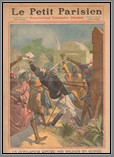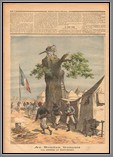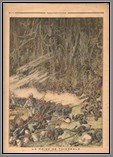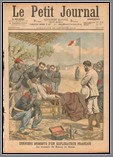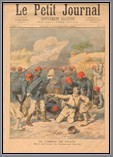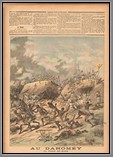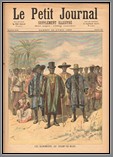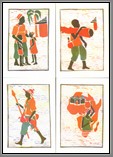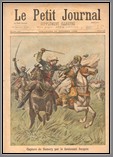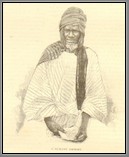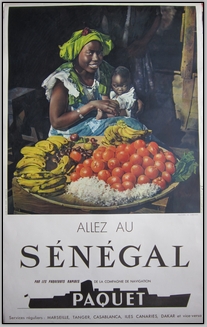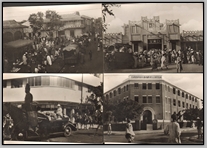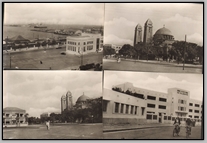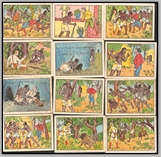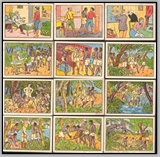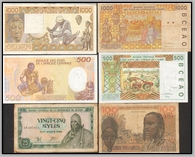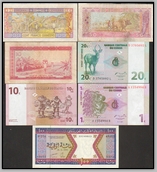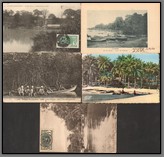French West Africa
A collection of six illustrations from Le Petit Journal and Le Petit Parisien , 1892-1893, on the Second Dahomey War. B
Price: $450.00
Note: In 1890, the Fon kingdom of Dahomey and the French Third Republic had gone to war in what was remembered as the First Franco-Dahomean War over the former's rights to certain territories, specifically those in the Ouémé Valley. The Fon ceased hostilities with the French after two military defeats, withdrawing their forces and signing a treaty conceding to all of France's demands. However, Dahomey remained a potent force in the area and quickly re-armed with modern weapons in anticipation of a second, decisive conflict. After re-arming and regrouping, the Fon returned to raiding the Ouémé Valley, the same valley fought over in the first war with France. Victor Ballot, the French Resident at Porto-Novo, was sent via gunboat upriver to investigate. His ship was attacked and forced to depart with five men wounded in the incident. King Benhanzin rejected complaints by the French, and war was declared immediately by the French.
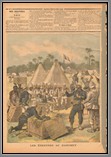 FA 102
FA 102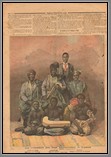 FA 102On June 15, 1892, the French blockaded Dahomey's coast to prevent any further arms sales. Then, on July 4, the first shots of the war were fired from French gunboats with the shelling of several villages along the lower Ouémé Valley. The carefully organized French army began moving inland in mid-August toward their final destination of the Dahomey capital of Abomey. Battles were fought at Dogba, Poguessa, Adegon and Akpa. From November 2 until November 4, the French and Fon armies fought on the outskirts of Cana. By this time, Béhanzin's army numbered no more than 1,500 including slaves and pardoned convicts. On November 3, the king directed the attack on the French bivouac. Amazons seemed to have made up much of the force. After four hours of desperate combat, the Fon army withdrew. The fighting continued until the fourth. The last engagement at Cana, which took place at the village of Diokoué, site of a royal palace, was the last time Amazons would be used. Special units of the Amazons were assigned specifically to target French officers. After a full day of fighting, the French overran the Dahomey army with a bayonet charge.
FA 102On June 15, 1892, the French blockaded Dahomey's coast to prevent any further arms sales. Then, on July 4, the first shots of the war were fired from French gunboats with the shelling of several villages along the lower Ouémé Valley. The carefully organized French army began moving inland in mid-August toward their final destination of the Dahomey capital of Abomey. Battles were fought at Dogba, Poguessa, Adegon and Akpa. From November 2 until November 4, the French and Fon armies fought on the outskirts of Cana. By this time, Béhanzin's army numbered no more than 1,500 including slaves and pardoned convicts. On November 3, the king directed the attack on the French bivouac. Amazons seemed to have made up much of the force. After four hours of desperate combat, the Fon army withdrew. The fighting continued until the fourth. The last engagement at Cana, which took place at the village of Diokoué, site of a royal palace, was the last time Amazons would be used. Special units of the Amazons were assigned specifically to target French officers. After a full day of fighting, the French overran the Dahomey army with a bayonet charge.
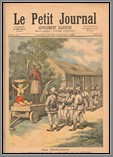 FA 102
FA 102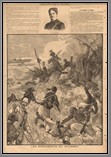 FA 102On November 5, Dahomey sent a truce mission to the French, and the next day saw the French enter Cana. The peace mission failed, however, and on the 16th of November, the French army marched on Abomey. King Béhanzin, refusing to let the capital fall into enemy hands, burned and evacuated the city. He and the remnants of the Dahomey army fled north as the French entered the capital on November 17. The French tricolor was hoisted over the Singboji palace, which survived the fire and remains in modern Benin to this day.
FA 102On November 5, Dahomey sent a truce mission to the French, and the next day saw the French enter Cana. The peace mission failed, however, and on the 16th of November, the French army marched on Abomey. King Béhanzin, refusing to let the capital fall into enemy hands, burned and evacuated the city. He and the remnants of the Dahomey army fled north as the French entered the capital on November 17. The French tricolor was hoisted over the Singboji palace, which survived the fire and remains in modern Benin to this day.
The king of Dahomey fled to Atcheribé, thirty miles north of the capital. Attempts were initiated to rebuilt the army and its amazon corps until the French chose Béhanzin's brother, Goutchili, as the new king. King Béhanzin surrendered to the French on January 15, 1894 and was exiled to Martinique. The war had officially ended.
Complete 1898 issue of Le Petit Journal featuring the capture of Samory Toure. Also an 1899 French illustration of Samory Toure, from the cover of obscure periodical Le Globe Illustre. eh
Price: $135.00
Note: Samori Toure (c. 1830 – June 2, 1900), also known as Samori Toure, Samory Touré, or Almamy Samore Lafiya Toure, was a Muslim cleric, a military strategist, and the founder and leader of the Wassoulou Empire, an Islamic empire that was in present-day north and south-eastern Guinea and included part of north-eastern Sierra Leone, part of Mali, part of northern Côte d'Ivoire and part of southern Burkina Faso. Samori Ture was a deeply religious Muslim of the Maliki jurisprudence of Sunni Islam. Ture resisted French colonial rule in West Africa from 1882 until his capture in 1898. Samori Ture was the great-grandfather of Guinea's first president, Ahmed Sékou Touré.
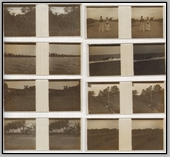 FA 080 FA 080 | 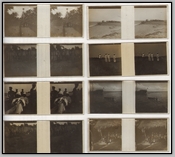 FA 080 FA 080 | 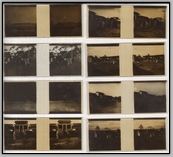 FA 080 FA 080 | 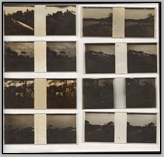 FA 080 FA 080 |
Collection of 38 positive glass slides of Cote d’Ivore taken in 1904. Shows local village nobility, trailleurs, local dancing, dress, village life, village men digging a large pit, colonial administrators close up, children playing, digging a trench through the bush for what appears to be a telegraph line, etc. All slides intact and good condition but no descriptions. If interested, there are slides from Madagascar and Indochina available from the same owner. B
Price: $600.00

